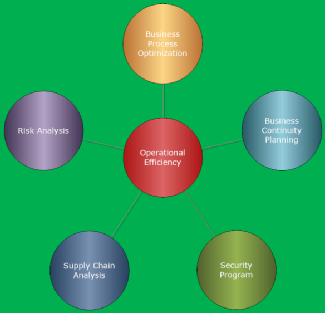

Operational Effectiveness
- Optimized Operations – Risk Focus
- Risk Defined Operational Goals
- Technology Assisted Operations
- Value Driven Operations
- Integrated approach for operations, continuity, and technology
Operational effectiveness combines the disciplines and tools we have already discussed into a comprehensive approach and way of conducting business. A business culture is defined by how we approach our daily tasks. At A Going Concern, we help our clients build a culture of continuity. That culture is developed by having clearly defined plans, governance, leadership, roles and responsibilities (as a start), an attitude of “we will recover because we have a plan and have practiced it.” A firm understanding of what is critical, what happens in our supply chain, and how we should proactively attack issues also help define a culture of continuity. There are many more examples that can be used; we’ve chosen these as being some of the key ones.
So how do you get operational effectiveness? A manufacturing example is probably the easiest to present. If you optimize your supply chain to the point of having no on-hand supply or finished inventory, your operation has the “best” approach to being lean. But if any supplier fails (no raw materials get delivered or no truck is available to pick up finished goods,) you have a potential disaster on your hands. However, if you know that a supplier outage can be resolved within 5 days and you maintain a five day inventory on-hand for raw materials, and if you have two contracted carriers that can pick up your finished goods, many small disturbances to operations are easily handled and never rise to being a disaster.
You’ve read the example above, and are now saying, “That is easy to say and hard to do,“ you are correct. It is also why few companies even try to tackle the issue on a large scale. Today’s supply chains are highly complex; finding the right mix of inventory on hand, financial cash flow, facility sizing, location, etc. is an art form; it is not a pure science. Together with A Going Concern, you can develop the framework and the guiding principles we’ll use in determining the operational model. From there, we can help you begin the process of becoming more resilient, having higher security and data protection, and developing a solid approach to technology usage and risks. We’ve found that by taking smaller steps and integrating the programs we provide can help significantly. As each component becomes part of the operation, the teams start to find the mix that makes sense and provides the most benefit at an acceptable cost. We call that a risk adjusted optimization, or a risk focused optimization.
This level of operations embodies the culture of resilience and demonstrates a company committed to remaining a going concern.

| Fred Bio |
| Keith Bio |
| Business Continuity |
| Technology Risk |
| Integrated Security |
| Operational Effectiveness |
| Memories Preservation |
| Ebola Hype |
| Risk Assessments for Health Care |
| Cyber Threat |
| Data Center Independence |